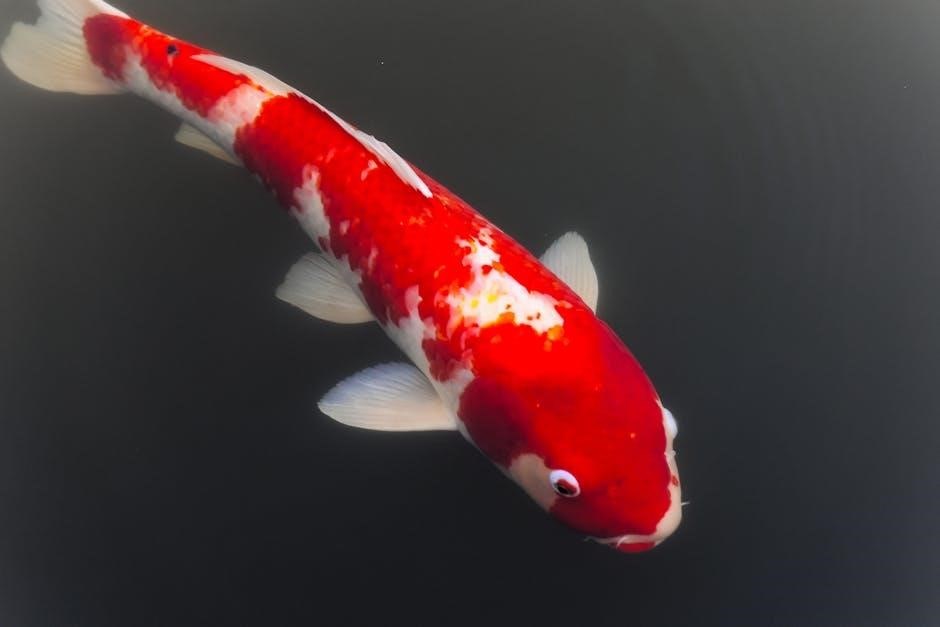your inner fish pdf
Your Inner Fish by Neil Shubin explores the evolutionary connection between humans and ancient fish, revealing how fossils, genes, and embryos uncover our shared ancestry. Available as a PDF, this groundbreaking book takes readers on a 3.5-billion-year journey through the history of the human body, tracing surprising links between our anatomy and that of fish, worms, and even bacteria. Shubin’s work bridges paleontology, genetics, and developmental biology, offering a fascinating perspective on human evolution and our “inner fish.”
What is Your Inner Fish?
Your Inner Fish refers to the evolutionary connection between humans and ancient fish, highlighting how our anatomy and biology are rooted in our aquatic ancestors. This concept, explored in Neil Shubin’s book, reveals that many human features, such as our limbs, teeth, and eyes, have evolutionary origins in fish. The idea emphasizes that humans are not separate from the natural world but are part of a continuous evolutionary journey. By studying fossils and genetic data, scientists can trace how fish-like traits evolved into the complex structures seen in humans today. This perspective underscores the deep interconnections between all life forms and challenges us to rethink our place in the natural world.
The Concept of Evolutionary Biology
Evolutionary biology is the scientific study of how life on Earth has diversified and adapted over time. It examines the processes that drive changes in species, such as natural selection, genetic drift, and speciation. By exploring the shared ancestry of all living organisms, evolutionary biology provides a framework for understanding the similarities and differences between species. This field integrates genetics, paleontology, and developmental biology to reconstruct the history of life. The concept is central to “Your Inner Fish,” as it explains how ancient traits in fish have been preserved and modified in humans. Evolutionary biology not only helps us trace the origins of life but also illuminates how species are interconnected through millions of years of shared history.

Neil Shubin and His Work
Neil Shubin is a renowned paleontologist and evolutionary biologist, best known for his groundbreaking discovery of Tiktaalik roseae, a 375-million-year-old fossil that bridges the evolutionary gap between fish and land-dwelling animals. His work has significantly advanced our understanding of how life transitioned from water to land. Shubin’s research combines paleontology, genetics, and anatomy to explore the shared history of species. He is also a professor at the University of Chicago and has written the award-winning book Your Inner Fish, which explains how ancient fish traits are embedded in the human body. His contributions have made evolutionary biology accessible to a broad audience, showcasing the deep connections between species and the enduring legacy of our ancient ancestors.

The Evolutionary Connection
The Evolutionary Connection explores how species share traits through common ancestry, revealing ties between ancient fish and modern humans. It explains natural selection’s role in shaping life’s diversity.
From Fish to Humans: A Brief Overview
The journey from fish to humans is a remarkable tale of evolutionary adaptation. Over millions of years, ancient fish evolved into tetrapods, developing limb-like fins and transitioning to land. These early creatures laid the foundation for modern vertebrates, including humans. Shared anatomical traits, such as bone structures in limbs and sensory systems, highlight our deep connection to aquatic ancestors. The fossil record, including discoveries like Tiktaalik, reveals intermediate forms that bridge fish and land-dwelling animals. Additionally, genetic studies show that many human genes have counterparts in fish, underscoring our shared evolutionary heritage. This transition not only shaped human anatomy but also influenced our physiology and behavior, making it a cornerstone of understanding our evolutionary history.
The Role of Fossils in Understanding Evolution
Fossils are the cornerstone of evolutionary biology, offering tangible evidence of life’s history on Earth. They provide a physical record of ancient organisms, revealing how species have evolved over millions of years. In “Your Inner Fish,” fossils play a crucial role in tracing the evolutionary journey from fish to humans. By studying fossils, scientists can identify anatomical similarities and transitions, such as the development of limbs and lungs in early tetrapods. These discoveries bridge gaps in the evolutionary timeline, showing how ancient traits in fish are still present in modern humans. Fossils like Tiktaalik and Panderichthys exemplify these transitions, highlighting the deep connection between aquatic and terrestrial life. Through fossils, paleontologists reconstruct evolutionary pathways, making them indispensable in understanding our shared ancestry with ancient fish.
Genetic Links Between Species
Genetic links between species reveal a shared evolutionary history, as demonstrated in “Your Inner Fish.” DNA sequences across different organisms show striking similarities, indicating common ancestry. For instance, humans and fish share genes controlling limb development, despite their morphological differences. These genetic parallels highlight how evolutionary processes have conserved essential biological pathways over millions of years. Mutations and natural selection have gradually adapted these genes to suit different environments, but their origins remain traceable. Such genetic continuity underscores the idea that all life forms are interconnected. By studying these genetic links, scientists like Neil Shubin uncover how ancient fish traits are embedded in the human genome, illustrating the profound impact of evolution on life’s diversity and complexity.
Key Discoveries and Insights
“Your Inner Fish” uncovers profound evolutionary connections, revealing how ancient fish traits shaped human anatomy and genetics. Neil Shubin’s groundbreaking discoveries, like Tiktaalik, illuminate our shared origins.
The Discovery of Tiktaalik Roseae
The discovery of Tiktaalik roseae in 2004 marked a landmark in evolutionary biology, providing a missing link between fish and tetrapods. This 375-million-year-old fossil, found in the Canadian Arctic, exhibited a unique combination of fish-like scales and fins with tetrapod-like limbs and a neck. Its adaptations, such as limb-like fins and a robust skeleton, suggest a transitional phase in evolution, enabling movement on land. Neil Shubin and his team identified these traits, revealing how ancient fish evolved into land-dwelling creatures. Tiktaalik bridges the gap between aquatic and terrestrial life, offering insights into the origins of human anatomy. This fossil underscores the deep evolutionary connections between humans and ancient fish, as detailed in “Your Inner Fish.”
How Fossils Reveal Human Anatomy
Fossils provide critical insights into the evolution of human anatomy by preserving the physical traits of ancient organisms. These remains allow scientists to trace the development of specific anatomical features over millions of years. For instance, the structure of the human hand mirrors that of early tetrapods, while the composition of the human skull shares similarities with ancient fish. These comparisons highlight the shared ancestry between humans and other species. Additionally, fossils reveal the embryological origins of human anatomy, showing how certain traits developed through genetic and environmental pressures. By studying these preserved remains, researchers can map the evolutionary pathways that led to modern human anatomy, offering a deeper understanding of our biological history and its connection to the natural world.

The Genetic Legacy of Ancient Fish
The genetic legacy of ancient fish is evident in the DNA shared between humans and their aquatic ancestors. Many genes that govern human development, such as those controlling limb formation and sensory systems, are traceable to early fish. These genetic remnants reveal how evolutionary adaptations in ancient species laid the foundation for complex human traits. For example, the genes responsible for the development of fins in fish are the same as those that guide the formation of human limbs. Additionally, the genetic blueprints for the human ear and eye show striking similarities to those of ancient fish. These shared genetic elements underscore the deep evolutionary connection between humans and their fish-like predecessors, illustrating how ancient DNA continues to shape modern biology.

The Book’s Structure and Themes
Your Inner Fish explores evolutionary connections through a structured narrative, blending fossil records, genetic insights, and anatomical comparisons to reveal humanity’s ancient origins and biological heritage.
Chapter Overview: A Journey Through Time
Your Inner Fish unfolds as a captivating journey through billions of years of evolutionary history. Each chapter delves into pivotal moments in life’s progression, from ancient fish to modern humans. Shubin explores how anatomical structures, such as limbs and digits, evolved in early vertebrates and persisted through time. The discovery of Tiktaalik roseae, a 375-million-year-old fossil, is highlighted as a bridge between fish and land-dwelling creatures. The book also examines genetic and developmental links, revealing how ancient traits influence human biology. By weaving together fossil records, genetics, and embryology, Shubin creates a seamless narrative that connects the past to the present. This approach makes the complex story of evolution accessible, engaging readers in a profound exploration of their own biological heritage.

Major Themes: Evolution, Development, and Anatomy
The book Your Inner Fish revolves around three central themes: evolution, development, and anatomy. Evolution is explored as the unifying force that connects all life forms, revealing how ancient species laid the groundwork for modern biology. Development examines how embryos and body plans evolve over time, showcasing how early life stages reflect ancestral traits. Anatomy highlights the remarkable similarities between human body structures and those of other animals, such as the bones in a human hand mirroring those in a whale’s flipper or a fish’s fin. Together, these themes illustrate how evolutionary processes have shaped the human body, with genetics playing a key role in preserving ancient features. This integration of biology and history provides a unique perspective on human origins and our shared evolutionary past.

The Role of Embryology in Evolutionary Biology
Embryology plays a crucial role in understanding evolutionary biology, as it reveals how developmental processes across species reflect shared ancestry. In Your Inner Fish, embryonic stages of different animals are compared to highlight evolutionary connections. For example, human embryos exhibit gill slits and tailbones, remnants of our fish-like ancestors, which disappear before birth. These embryonic similarities demonstrate how ancient traits are preserved across species, even if they no longer serve the same function in adults. By studying embryonic development, scientists can trace the evolutionary history of body structures, showing how humans and other animals share a common genetic blueprint. This link between embryology and evolution underscores the profound connections between life forms and our deep evolutionary heritage.
Scientific and Cultural Impact
Your Inner Fish has profoundly influenced scientific understanding and cultural perceptions, bridging evolutionary biology with accessible storytelling, inspiring new research and public appreciation for human evolution.
Reception of the Book in the Scientific Community
Your Inner Fish received widespread acclaim in the scientific community for its innovative approach to explaining evolutionary biology. Scientists praised Shubin’s ability to connect fossil records, genetics, and anatomy in a cohesive narrative. The book was lauded for its clarity and depth, making complex concepts accessible to both experts and laypeople. It sparked discussions about the importance of evolutionary biology in understanding human health and anatomy. Many researchers highlighted how the book inspired a new generation of scientists to explore evolutionary connections. The scientific community also appreciated Shubin’s interdisciplinary approach, which bridged paleontology, genetics, and developmental biology. The book’s success demonstrated the power of storytelling in advancing scientific knowledge and public engagement.

Popularizing Evolutionary Biology
Your Inner Fish played a pivotal role in making evolutionary biology accessible to a broad audience. By weaving together fascinating stories of scientific discovery, the book demystified complex concepts like fossils, genetics, and anatomy. Shubin’s engaging narrative style helped readers connect with the evolutionary journey of life on Earth. The book’s success in popularizing science was further amplified by its adaptation into a PBS documentary series, reaching millions worldwide. It not only educated the public but also inspired a new appreciation for the deep connections between species. Your Inner Fish became a landmark in science communication, proving that evolutionary biology could captivate both scientists and non-experts alike. Its impact continues to resonate, fostering a wider understanding of our shared evolutionary heritage.
Your Inner Fish in Popular Culture
Your Inner Fish has transcended academia, leaving a lasting mark on popular culture. The book’s engaging narrative and groundbreaking insights inspired a PBS documentary series, introducing its concepts to a broader audience. This adaptation not only simplified complex evolutionary ideas but also made them visually accessible, further cementing the book’s influence. Beyond the documentary, Your Inner Fish has sparked discussions in media, podcasts, and educational programs, becoming a cultural touchstone for understanding human evolution. Its ability to bridge science and storytelling has made it a favorite among both educators and entertainers, ensuring its relevance in contemporary conversations about our shared evolutionary history.
The book concludes by emphasizing our deep evolutionary connection to ancient fish, shaping human anatomy, medicine, and our understanding of life’s shared journey and heritage.
The Significance of Understanding Our Inner Fish
Understanding our inner fish reveals the profound evolutionary connections that shape human biology, offering insights into anatomy, genetics, and the shared history of life on Earth.
By tracing the legacy of ancient fish in our bodies, we gain a deeper appreciation for how evolutionary processes have crafted modern organisms, including humans.
This understanding bridges biology, medicine, and our place in nature, fostering a broader perspective on human evolution and the interconnectedness of all living beings.
Such knowledge not only enriches scientific inquiry but also inspires a sense of wonder and responsibility toward the natural world and our shared evolutionary journey.
Future Directions in Evolutionary Research
Future evolutionary research will likely focus on uncovering more fossil records and genetic data to refine our understanding of human origins and species connections.
Advances in technology, such as high-resolution imaging and AI-driven analysis, will enable scientists to study fossils and genetic sequences with unprecedented precision.
Interdisciplinary collaborations between paleontologists, geneticists, and developmental biologists will continue to shed light on how ancient traits influence modern organisms.
Exploring uncharted regions for new fossils and studying the evolution of specific traits could reveal missing links in the evolutionary timeline.
Such research will not only deepen our understanding of life’s history but also inspire new medical and biological innovations, offering practical applications for humanity.
The Broader Implications for Human Understanding
Understanding our inner fish reveals the deep connections between life forms, fostering a sense of unity across species and ecosystems.

It challenges humans to rethink their place in nature, emphasizing that we are not separate from the natural world but part of its continuum.

This perspective encourages humility and responsibility, inspiring stewardship of the planet and its diverse life forms.
By tracing our shared evolutionary history, we gain insights into human behavior, health, and cognition, bridging biology with psychology and culture.
Such knowledge not only enriches scientific understanding but also promotes empathy and curiosity about life’s intricate web.
Ultimately, it invites us to embrace our evolutionary legacy as a foundation for understanding ourselves and our role in the world.
